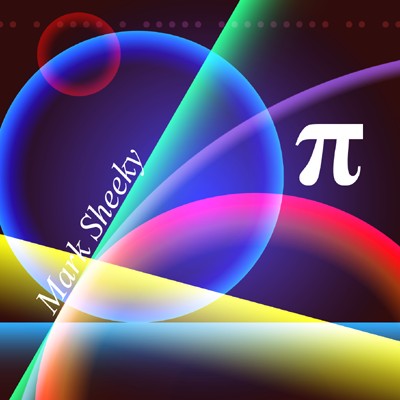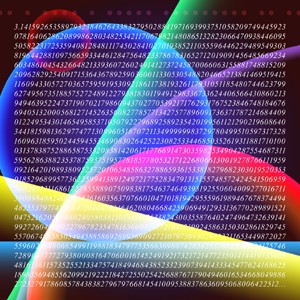Pi
Mark Sheeky
2010
 |
|
Pi
Mark Sheeky 2010 |

|

|

|
|
Track List
1. The Ratio (01:12)
2. 256 Binary Digits (00:45) 3. The Clockwork Harpsichord (02:48) 4. Stranded At Moonbase Eight (04:44) 5. Decimal Drumkit (00:32) 6. Binary Ocean (03:20) 7. Pentatonic Fantasy (02:34) 8. The Crystal Garden (05:52) 9. Trio (02:06) 10. Base 36 (31:41) 11. Pi (03:14) 12. The Enigma Of Pi (00:45) |
|
About This Album
Pi is an experimental album about that mathematical constant. The project began as a programming extension to my music software, Prometheus, adding the capability to import music from text files. I decided to convert pi to base twelve (dodecimal) instead of the typical base ten (decimal), and play it in one octave on a chromatic scale, to see what it sounded like. Interestingly, the music does not sound like random notes and does appear to have a deeper structure.
All of the melodies and irregular timings on this album are representations of pi in different number bases. The music varies from slow calming tunes, to complex multi-layered melodies or tracks that represent other aspects of this remarkable number. The Ratio explores the ratio of 1:pi and ends with a chord of C:C*pi. Musical scales are exponential so a chord of 1:2 would play a note and the same note an octave higher. A ratio of 1:4 would play the root note and a tone two octaves higher. A ratio of 1:pi places the second note somewhere in the second octave, which is just above F compared to a root note of C. The track opens with clicks that bracket a tone of 1 Hz that lasts 1 second. Many of the timings in the track are pi beats (3.141 beats). 256 Binary Digits plays the first 256 digits of binary pi, that is pi in base two. The Clockwork Harpsichord explores tetratonic pi; pi in base four. Pi is played on the notes C, E, F and G, the only notes used for this piece. The timing is regular. Stranded At Moonbase Eight plays pi over a regular octave, C to C, using pi converted to base eight. The timing is also in base eight, with the gaps between notes represented by the digits of pi. Base eight pi on this natural scale tends to sound organic and calming. Decimal Drumkit explores the timing of decimal pi (3.14159 etc.) and uses a drum kit to play the first few digits. Binary Ocean uses binary pi (base two) to play different overlapping instruments. A slow wave undulates, then a deeper drum at double speed (that plays only the ones), then wind chimes at double speed again, then a piano, then a piano and flute at the maximum speed. As is the nature of binary, only two notes are used for each instrument, high and low. Pentatonic Fantasy uses the pentatonic scale (black notes) and pi converted to base five. The timings are regular but the music pauses on multiples of five beats and the music appears to harmonise in a natural and comfortable way. The Crystal Garden explores pi in base six, and uses the notes C,E,G,A,C and E. The effect is a calming mix of major and minor tones. The timing is regular. Trio explores pi in base three. A regular waltz timing is used, and the notes D,E and F. Base 36 is pi in base thirty six, spread over three whole musical octaves. The timing is decimal. The effect is rather jarring and unsteady, but this track reveals more of the natural structure of pi than perhaps any other. The track is 31.41592654 minutes long. Pi is pi played in base twelve over one octave, the most natural base to explore the sound of pi. The track is played in a pure sine wave with a tiny amount of echo, and lasts 3.141 minutes. The Enigma Of Pi acts as an epilogue and layers many of the earlier representations of pi before ending with a piano playing C raised to the ratio of pi. Between the closing clicks a tone of pi Hz is played for pi seconds. |
|
|